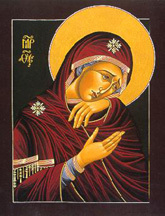
For a long timeat least since the early 13th centuryCatholics have prayed to her, the Mater Dolorosa, and under a kindred title, Our Lady of Sorrows, she is the patroness of the Congregation of Holy Cross, Notre Dames founding religious community.
The grieving Mother of God is well known here.As are her sorrows, seven in all:
Simeons prophecy in Luke 2:34, which includes his warning that the anguish of Marys motherhood would pierce her heart through; her harrowing experience as a refugee, narrowly escaping a murderous dictator to hide out in Egypt (Matthew 2:13); every mothers nightmare when her little boy went missing for three days (Luke 2:43); seeing her son, an unjustly held detainee, jeered, humiliated and tortured on a Jerusalem street (Luke 23:26); helplessly watching him in his death throes (John19:25); awkwardly salvaging his ravaged corpse (Matthew 27:57); and arranging a disgraced sons furtive and hasty burial in a borrowed grave (John 19:40).
These seven sorrows of Mary have inspired a rich variety of music over the years. Palestrina, Scarlatti, Haydn, Dvoák, Vivaldi, Rossini, Gounod and Poulenc are only a few of the composers haunted by the grieving Mary.The sorrows also have furnished popular piety with one of the most arresting and familiar images in Catholic iconographythe seven swords which graphically transpierce Our Ladys heart.
Marys sorrows are far from alien to a 21st century wounded by genocide in Darfur, drowning and starving in Myanmar, cruelty in Guantanamo and Abu Graib, and the random horror of the Chinese earthquake.Piercing grief is as ancient as human weeping.And as contemporary, deeply familiar and reliably expected.The loved one lost, whether due to the carelessness of nature or the cruelty of man, is something everyone has known, or fears to learn some day.Our Lady of Sorrows is the patroness of all that pain.
It is particularly appropriate that she be invoked at the site of the new mausoleum complex built last year in Notre Dames Cedar Grove Cemetery.The University has commissioned artist Robert Graham to carve a sculpture of Our Lady of Sorrows to be installed and blessed there on Sept. 5.
Grahams commissions over the years have been impressive.Not the least of them is a statue of Holy Cross founder Blessed Basil Anthony Moreau, C.S.C., which was installed in the northwest apsidal chapel of Notre Dames Basilica of the Sacred Heart last fall in honor of Moreaus beatification.Other prominent Graham works include the bronze doors of the Cathedral of Our Lady of the Angels in Los Angeles; thePrologueaddition to the Franklin Delano Roosevelt Memorial in Washington, D.C.; the CharlieBirdParker Memorial in Kansas City, Mo.; the Duke Ellington Monument in New York City; and the Olympic Gateway at the Los Angeles Memorial Coliseum.
Here at Notre Dame, the Snite Museum of Art will mount an exhibition of Grahams works, titledThe Human Form,from July 6 to Aug. 17.
Notre Dame is fortunate to have important artworks by American master Robert Graham in our Basilica, within Cedar Grove Cemetery and in the permanent collection of the Snite Museum of Art,said Snite director Charles R. Loving.During a time when most American artists focused on abstract, minimal, and conceptual art, Graham quietly and steadfastly honed his extraordinary ability to represent the anatomy, beauty and sensuality of the human form.
People at Notre Dame are eager to see what such an artist will make of Our Lady of Sorrows, and the awaited sculpture should be something to behold.As the husband of the actress Anjelica Huston, Graham surely knows something of the mystery of feminine beauty, and his widely admired explorations of the human form in a wide variety of media and materials promise that this Mary will not be an ethereal idea, but a real womanbeautiful, gentle, compassionate and brave.
A woman, the woman, whose quintessential femininity, maternal privilege and unbounded love enable her to weep for the whole world.
TopicID: 28347